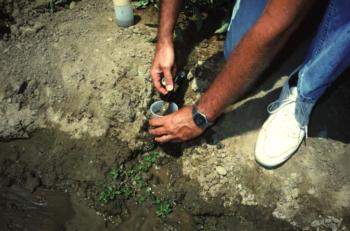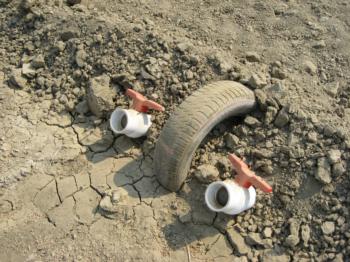Flushing

The key to adequate flushing is to provide an open-line flushing velocity of at least 1 foot per second at the end of the drip line. For a 5/8-inch-diameter lateral, a flow rate of 1 gallon per minute at the end of the lateral is required to achieve that velocity. A flow rate of 2 gallons per minute is necessary for a 7/8-inch-diameter drip line. You may need to use a trial-and-error system to determine how many laterals you can flush at the same time while still mainaining the desired flushing flow rate.
 Flush valves for drip tape lines manifolded together Photo L. Schwankl.Row crops
Flush valves for drip tape lines manifolded together Photo L. Schwankl.Row crops

A flushing manifold, especially in a row-crop drip tape system, is sometimes used at the ends of laterals to reduce the amount of labor needed to conduct flushing. These manifolds must be properly designed to ensure that they will allow the deposited material to pass out of the system and it should have a water velocity of 1 foot per second. This requires a progressively increasing flushing manifold diameter to accommodate the increasing manifold flow rate. The flushing manifold flow rate will be smallest at its beginning (where the flow rate equals the outflow rate of the drip line) and maximum at the manifold’s outlet.
Continue flushing until clean water flows out of the end of the lateral. It is a good idea to collect samples of the flushed material to determine its composition.
 Self-flushing end caps on the lateral ends of an orchard subsurface drip system Photo L. Schwankl.Permanent crops
Self-flushing end caps on the lateral ends of an orchard subsurface drip system Photo L. Schwankl.Permanent crops

The first steps in flushing a tree or vine crop microirrigation system are to flush the mainlines and then the submains using flush valves, which should have been installed in the system and sized to allow sufficient pipeline flow velocity to wash away contaminants. All filters on the system should also be examined to make sure they are clean and operating properly.
Laterals in permanent crops are generally flushed by hand, with several (usually fewer than 10) lateral line ends opened at a time and allowed to flush clean. By opening only a few lateral lines at once, you ensure that there will be sufficient flow to thoroughly flush the lines. Start out by flushing the lines every 2 to 3 weeks. If the lines do not flush clean within a minute or two, you may need to flush more frequently. If the lines appear to still be clean at the 2- to 3-week interval, you can flush less frequently.
Self-flushing lateral line end caps are also used in microirrigation systems for permanent crops. The end caps are normally open, but they close when the system reaches a certain pressure. That way they have a short flush at the beginning and end of each irrigation. Periodic manual flushing is still recommended because self-flushing end caps do not provide a thorough, high-velocity flush. In some instances, the end caps may not close completely and may leak.
Flushing frequency
How often the system should be flushed depends on the irrigation water quality and the degree of filtration. Generally, flushing should be performed every 2 weeks, although less-frequent flushing may be sufficient in some cases. The laterals should also be flushed after any fertilizer or chemical injection and for periodic chlorine injections. A simple way to determine how often flushing is needed is to observe how many contaminants come out during flushing. If very few contaminants flow out, especially from the lateral lines, you can probably flush less often. The reverse also holds true: If large amounts of material wash out, flushing should be done more often.
